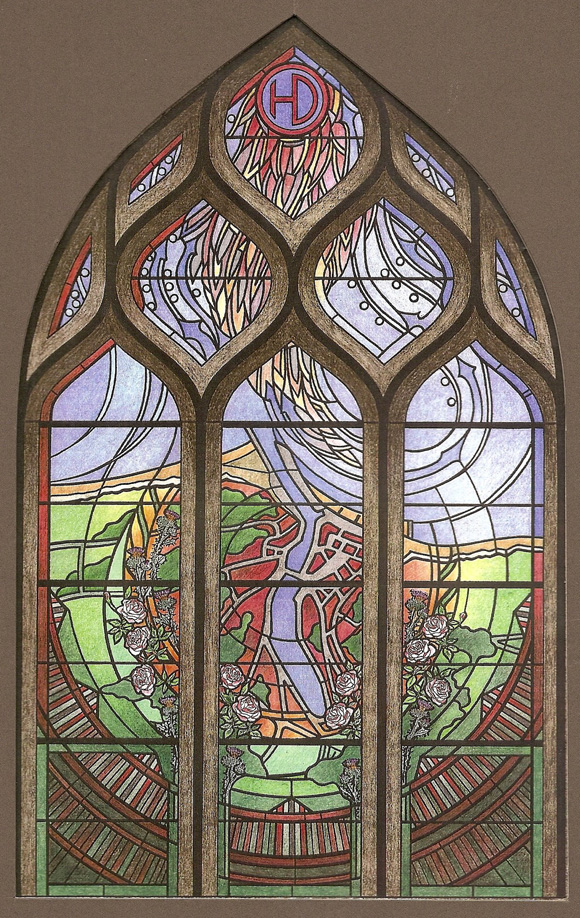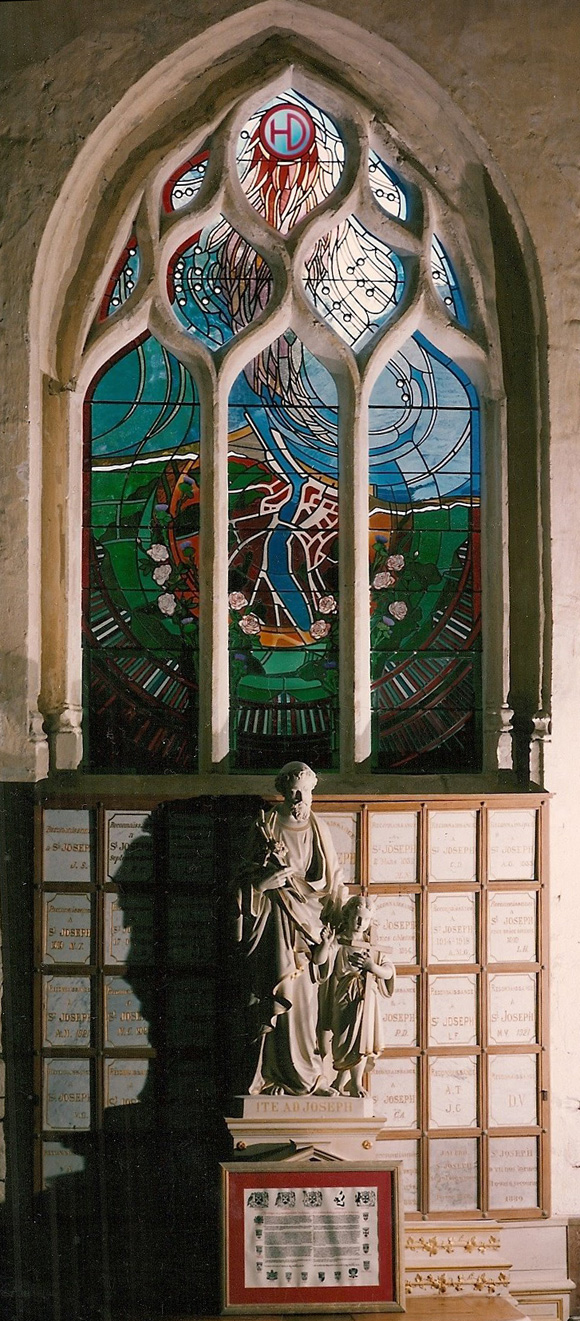St. Valéry
Stained Glass Window
This window, dedicated in June 1990, is a gift from the highland cities and towns of Scotland and commemorates fifty years of their special association with the people and township of St. Valéry en Caux with Inverness and began in the difficult circumstances of 1940 when the German army converged on the town and the combined allied forces comprising the French 9 St Corps and the 51st Highland Division.
The total design concept has an underlying feeling of turbulence appropriate to the events remembered but avoids any direct war imagery which seems out of place within the church, relying rather on symbolic imagery, colour form to suggest ideas and stimulate the enquiring mind to discover and interpret the meanings within the window.

St Valéry, Commemorative Window
show infoDescription:
This window shows the harbour inlet and town of St. Valéry within an aerial landscape incorporating the surrounding countryside which was involved in the action of 1940, together with the abrupt division by the cliffs between it and the sea which were both of extreme significance to the events of the time.
Tags:
The window shows the harbour inlet and town of St. Valéry within an aerial landscape incorporating the surrounding countryside which was involved in the action of 1940, together with the abrupt division by the cliffs between it and the sea which were both of extreme significance to the events of the time.
Intentional within the design is also a visual parallel to the imagery and concepts suggested in Revelation 12 of good prevailing and the casting out of evil. The harbour channel and surrounding town of St. Valéry, a central area of red and orange to depict the destruction and fires of battle, can also be seen as being, "clothed in the sun and fires of battle", can also be seen as being "clothed in the sun with the moon under her feet" (Rev. 12vl) with the harbour itself "giving birth" into the sea and towards possible freedom.
The outer perimeter of flames forms a king of wreath around the town within which are entwined roses and thistles in reference to the joint action and to evoke the words of General de Gaulle in Edinburgh on June 23rd 1942 when he remembered the thousands of Scots whose blood was shed with the French during the previous war, the monument to their memory at Buzancy with its inscription and medallion referencing roses and the thistle, and added "if the roses of France are blood-stained today, they still cluster lovingly around the thistle of Scotland".
The encircling oppressive forms in the lower sections of the window represent the advancing German army. These are arranged in blocks to depict the various divisions advancing from different directions and within which the pattern suggests the movement of tanks which in superior force Rommel used to this advantage on this occasion. The seven arrowheads with the red white and black colours of the German army, "the seven headed dragon" (Rev.12v3) connect with the red borders which twist into the upper sections of the window on the left as the tail of the dragon "drawing one third part of the stars of heaven".

St Valéry Stained Glass window
show infoDescription:
This memorial window, dedicated in June 1990, is a gift from the highland cities and towns of Scotland and commemorates fifty years of their special association with the people and township of St. Valéry en Caux with Inverness which began in the difficult circumstances of 1940 when the German army converged on the town and the combined allied forces comprising the French 9 St Corps and the 51st Highland Division.
Tags:
The upper sections of the window should be read as both sea and sky, often indivisible at the horizon, thereby allowing for the concept of the earthly below the heavenly above. Within this area of indeterminate blue there is some indication of movement away from St. Valéry, by sea, suggesting the limited escape of those who were later. to reform with others to create the new 51st Division which was eventually to return and liberate the town.
At the very top of the window the HD emblem can be· seen central to a force of descending forms which by their shape and directional inference could represent the boats to bring the avenging forces of 1944, suggesting the promise of liberation, but also forming a kind of angel wing, a more celestial symbol of the forces of good on high against the evil below. "And there was war in heaven : Michael and his angels fought against the dragon... which was cast out" (Rev. 12v7.8).
"And they overcame him by the blood of the lamb and by the word of their testimony: and they loved not their lives unto the death" (Rev. 12Vl1).
Read about the key events relating to St. Valéry (below).
General Fortune considered all the options, a counter attack, further resistance, retaking the town but against this there was no possibility of evacuation or support, the men were exhausted and virtually out of ammunition, with no artillery ammunition at all. Shortly before 1000hrs on the 12th June General fortune took the most difficult of decisions - to surrender...
With the "Breakout" battle complete the 51st Highland Division has several days to recover before the advance continued. From Lisieux they advanced East crossing the Seine dealing with the enemy rear guard. The intention was to isolate the port of Le Havre... and on to St. Valéry.
